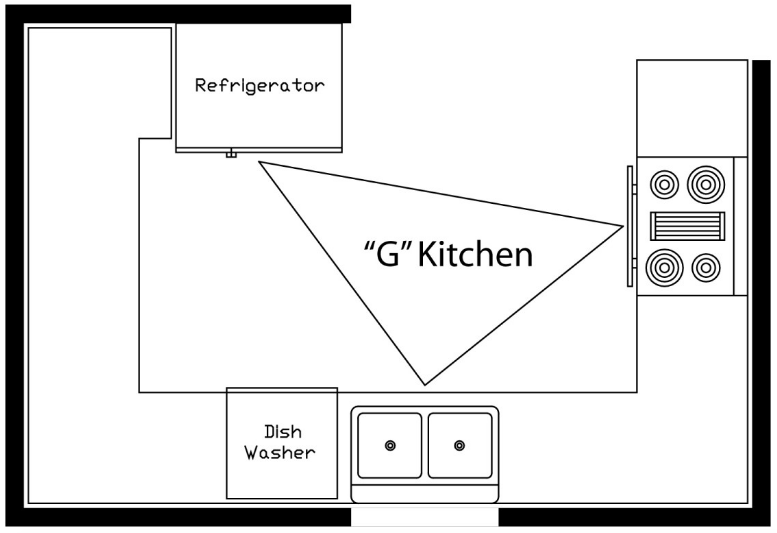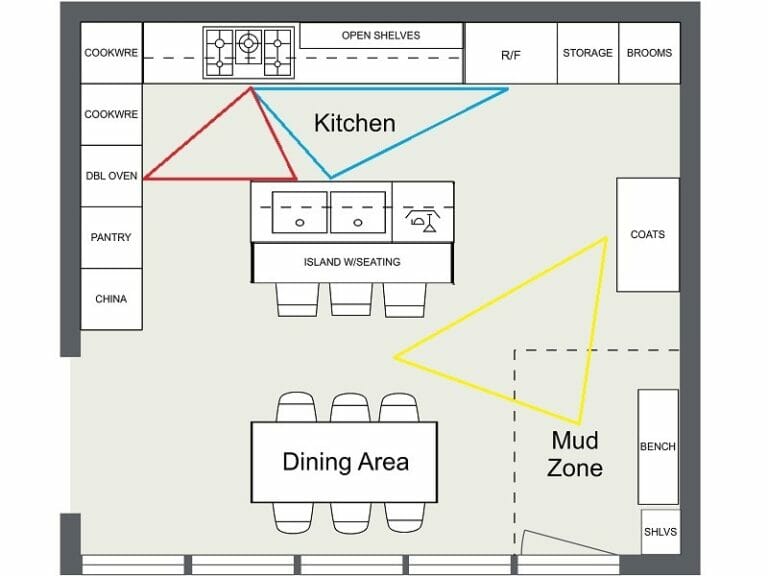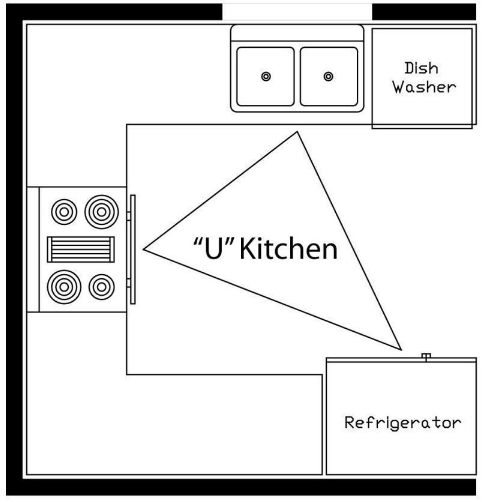Kitchen Design Understanding the Work Triangle and Kitchen Layouts
Having a good layout for your kitchen is important, because the kitchen should be an efficient and pleasant area in which to prepare meals and do related tasks. Understanding the kitchen work triangle concept and the basic kitchen layouts is a valuable starting point for having a good kitchen design that you like.
The kitchen work triangle consists of the distance between the sink, refrigerator and range or cooktop. Each one of these areas becomes a focal point in the kitchen and forms the three points of a triangle with different distances between them. Done correctly, the kitchen work triangle provides the most efficient food preparation area layout in the kitchen.
Whether youre remodeling an existing kitchen or building a new one, an efficient design means that your work triangle minimizes the number of steps the cook must take between the three areas during meal preparation and cleanup. The total distance from the sink to the stove to the refrigerator and back to the sink should be not less than 12 feet total nor more than 27 feet. Each triangle leg should measure between 4 and 9 feet in length. The kitchen isles should be at least 42 to 48 inches wide to allow people to move around easily and for appliances to be opened with ease.
When selecting the floor plan for your kitchen, here are basic kitchen layouts to consider:
* L-Shaped Kitchen - this is the most popular kitchen design. It consists of a long leg and a shorter one and this type of design can be used in small and large kitchens. The L-shaped kitchen gives you the possibility of having a center island depending on the space available. In general, this design will have 2 or 3 appliances on one wall. The usual arrangement is to have the refrigerator at one end, the range or cooktop at the other end with the sink located in the middle. This shape of kitchen generally provides good traffic flow.
* Double L-Shaped Kitchen - this kitchen design has a lot of cabinet space and plenty of counter space. This design is used in large kitchens with two cooks, and it has two or more entering areas, which can cause traffic flow problems. To avoid some of these problems, create two separate working areas on each L of the kitchen so that workflow does not get interrupted by human traffic.
* U-Shaped Kitchen - this kitchen design shape has three walls instead of two, and the sink usually is located in the middle wall section. The refrigerator and range or cooktop are usually on the side walls opposite each other. The U-shaped kitchen design gives room for ample countertop space, and you have three walls for cabinets and appliances. This kitchen layout tends to create a working triangle that is very efficient.
The only problem with this type of kitchen design is that sometimes the two U corners are not used appropriately. Make sure you buy the appropriate storage items for the corner cabinets created by the U shape design. The U shape design can also create dark kitchens because of the shape and the amount of cabinets. Using skylights, large windows, lots of under-cabinet task lighting and light colors will help keep the kitchen bright with sufficient light to see what youre doing.
* G-Shaped Kitchen - this type of kitchen shape is becoming very popular, and it gives you a fourth wall to use. The G-shape can be used if you have more than one cook in the house. This fourth wall section can be used for a counter, island and storage space.
With this kitchen layout you can have two sinks, perhaps two cooktops or two ranges. You could have two working triangles -- one for sink, cook top or range and refrigerator and a second working triangle with another sink, built-in grill and cooktop. It allows two cooks to do different things at the same time and entertain large groups of people.
* Single-Wall Kitchen - if you do not have much space, you may only be able to have an I-shaped kitchen. No problem. Just be sure the sink is placed between the refrigerator and the stove. Locate the refrigerator so that the refrigerator door opens away from the kitchen sink. This is a very common arrangement for small kitchens in narrow spaces.
* Galley-Shaped Kitchen - this type of kitchen design is more common in apartments or in homes where space is limited -- it is often called the corridor style. The kitchen cabinets and the appliances can be located on opposite walls for better work flow -- place the range or cooktop on one side of the kitchen along one wall and the refrigerator and sink on the opposite wall.
To eliminate traffic issues in this type of kitchen design, one entry is often closed off. This type of layout should only be used by one cook. If you want to maintain both exits, place the refrigerator near the end of the galley kitchen for easy access -- this way, your family and friends can reach the refrigerator without interfering with the person who is cooking.
If you need extra storage in the galley kitchen, install tall kitchen cabinets that go all the way to the ceiling. Wall storage is crucial -- buy a stepladder to use when you need to reach the upper shelf of the cabinets, and place the items you use less frequently on the upper shelves.
By understanding the kitchen work triangle concept and how you want your kitchen to function, youll be more likely to create the kind of kitchen youve always wanted. Today, kitchens are often viewed as the hub of the home as well as a social center for family and friends. Planning your kitchen can be a challenge, but the rewards youll receive are very much worth the time and effort.









0 Response to "Kitchen Design Understanding the Work Triangle and Kitchen Layouts"
Post a Comment